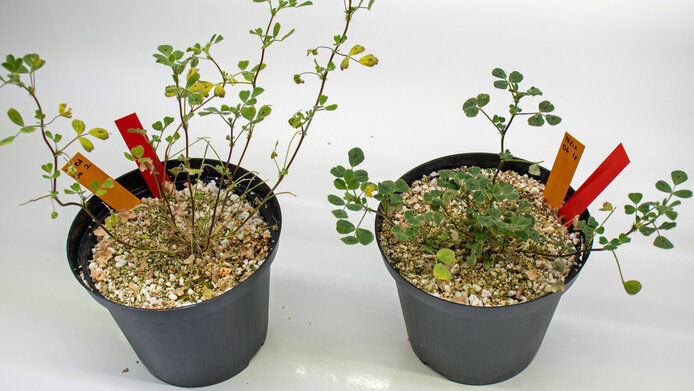Old friends – new benefits

An old love never fades. This very special positive interaction between legumes and soil-dwelling bacteria was discovered and described as early as 130 years ago. Peas, beans, Medicago truncatula, lupines, lentils and soybeans can take nitrogen from the air with suitable soil bacteria for which they provide a habitat in the form of root nodules. Biologist Stefanie Wienkoop and her team have now discovered that this co-operation helps plants such as Medicago truncatula, a forage plant, not only to thrive better in nutrient-poor soils but also to withstand drought better. Given advancing climate change, we may expect to be confronted more frequently with drying out soils and delayed irrigation. This makes it all the more important to understand exactly how this positive interrelationship (symbiosis) works. In the context of a project funded by the Austrian Science Fund FWF, Wienkoop has investigated in greater detail the role played by the protein ferritin, which is involved in initiating and maintaining the positive symbiosis.
Experiments with forage plants
The project is based on a preliminary study that was also funded by the FWF. Principal investigator Stefanie Wienkoop: “We had observed that the plants with the symbiotic soil bacteria were better able to cope with low soil moisture levels than plants that were fertilized. We didn't even have to go to the lab to ascertain this: the stay-green effect was visible to the naked eye.” When the experimental plants did not get water for a few days, their leaves did not wilt as quickly, because they were being probably helped by the interaction with their bacterial cohabitants. In turn, they recovered more quickly when receiving water again. In contrast, fertilized plants without root nodules lost more leaves or even died. In the current project, the team is also working with Medicago truncatula as a stand-in for peas, beans or soybeans. The plant grows worldwide and is used as animal feed. While it had been thought that resistance to drought was purely genetic, the investigations showed that it is strongly influenced by the relationship with symbionts. The Wienkoop’s research team at the University of Vienna was able to provide confirmation in experiments that compared extremely different groups.
Personal details
Stefanie Wienkoop studied plant biology in Germany, followed by positions in Canada, Denmark and at the Max Planck Institute for Molecular Plant Physiology in Potsdam-Golm (Germany). Since 2008, she has been conducting research at the University of Vienna, where she heads the “Plant-Microsymbiont Interaction” (PMInt) group. The project "Symbioprotein Ferritin" received EUR 133,000 in funding from the Austrian Science Fund FWF.
More information
Benefits for “high performers” and “low performers”
It was known from a US study that some varieties of Medicago truncatula were green high performers even at low soil moisture levels. Others wilted more quickly (low performers). The Vienna team now selected their test plants from these two extreme groups. One half of the test plants from both groups was fertilized, meaning they had no partner organisms in the roots. The other was provided with symbionts for nitrogen supply in the laboratory and formed root nodules. After 4 to 5 weeks of growth, all plants were experimentally exposed to severe drought stress (with soil moisture levels below 15 percent). They received no water for 6 to 9 days, which corresponds to prolonged dry periods as sometimes observed in Europe. The researchers measured a broad metabolic profile – before the stress experiment and three days after rewatering – as well as the content of the protein ferritin in leaves and roots. As Stefanie Wienkoops explains, they thus found and confirmed a “symbiont-induced stay-green effect”. Regardless of genetic makeup (high or low performer), all plants with bacterial cohabitants tolerated the drought better. These findings are going to be published soon.
Ferritin, matchmaker protein
So what is the role of the protein ferritin? It was known that this complex of proteins captures iron in plant cells and releases it again in leaves or roots. This nutrient, which is difficult to obtain, needs to be well buffered and kept in balance. Wienkoop calls ferritin a “symbio-protein” because it also initiates symbiosis with nitrogen-fixing soil bacteria in legumes. This role has probably been overlooked in the past, because the protein is basically found in all plants. As ferritin occurs in different chemical forms at different locations in the plant, its determination is a complex undertaking. Ferritin also plays a role in the formation of root nodules. And once the symbiosis is in place, the ferritin content increases in the leaves to protect them from wilting during drought. The team is currently conducting mass spectroscopy tests to identify and quantify the ferritin content and the chemical forms in various experimental phases and plant parts using a specifically developed measuring protocol. For purposes of comparison, the team is also measuring genetically modified plants with downregulated ferritin levels.
Sharing is caring
Currently, legume seed breeding is aiming for high yield in fertilized soil. When legumes obtain nitrogen from the air with the help of symbionts instead of from fertilized soil, their metabolism undergoes changes that affect the plant’s immune system. This usually means slower growth and somewhat lower yields. But if drought stress and irrigation problems increase as a consequence of climate change, symbiotic legumes will provide an added benefit.






